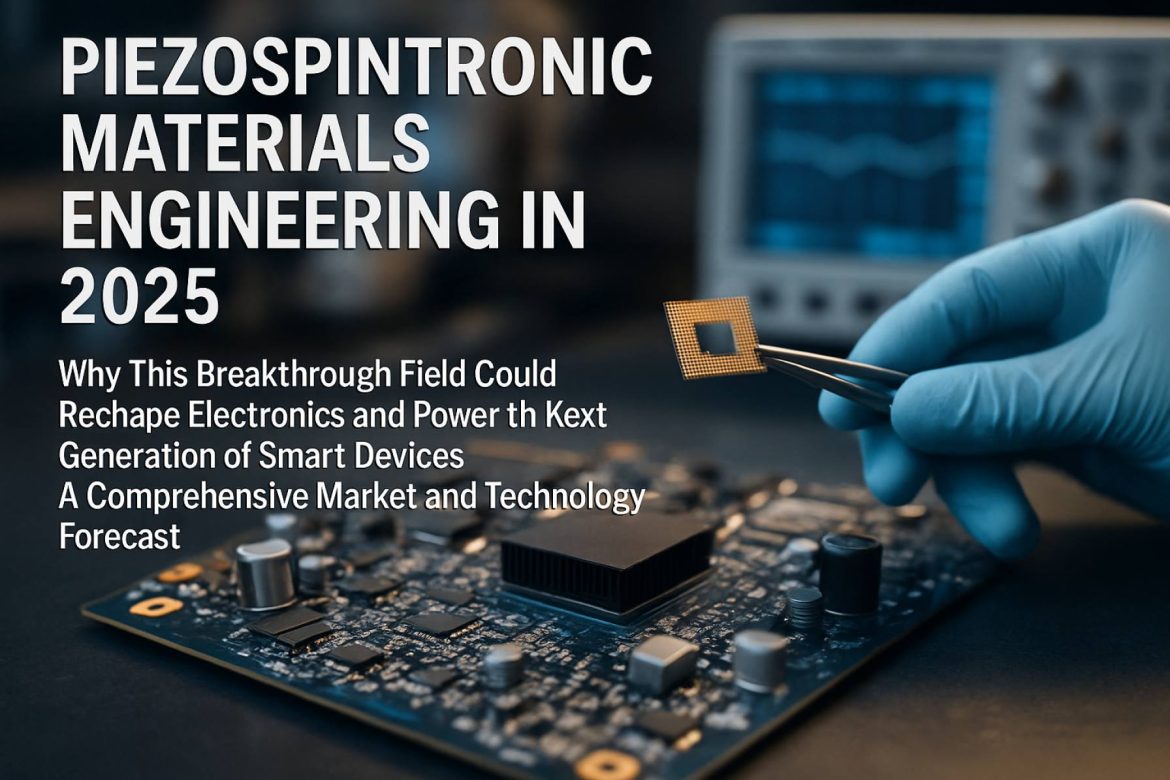Piezospintronic Materials: The Next $10B Tech Revolution? 2025–2030 Market Outlook Revealed!
Table of Contents
- Executive Summary: Defining the Piezospintronic Opportunity
- 2025 Market Size, Growth Drivers, and Key Forecasts
- Core Technologies: Materials Science and Innovations
- Leading Companies and Industry Alliances
- Application Roadmap: From Wearables to Advanced Robotics
- Manufacturing Challenges and Supply Chain Dynamics
- Regulatory Landscape and Standards (IEEE, ASTM, etc.)
- Competitive Analysis: Global Hotspots and New Entrants
- Investment Trends and Strategic Partnerships
- 2025–2030 Outlook: Disruptive Potential and Future Scenarios
- Sources & References
Executive Summary: Defining the Piezospintronic Opportunity
Piezospintronic materials engineering, at the intersection of piezoelectricity and spintronics, is rapidly emerging as a transformative field in the development of next-generation nanoelectronic devices. Characterized by the coupling of mechanical stress, electronic charge, and spin degrees of freedom, piezospintronic materials enable the manipulation of spin currents via mechanical means. This unique capability positions them at the forefront of innovation for applications in energy-efficient memory, logic devices, sensors, and quantum computing components.
As of 2025, academic and industrial research consortia are accelerating the exploration and synthesis of novel materials exhibiting strong piezospintronic effects. Layered two-dimensional (2D) materials, such as transition metal dichalcogenides (TMDs) and van der Waals heterostructures, have demonstrated promising properties, offering tunable electronic and spintronic behaviors under mechanical strain. Companies like 2D Semiconductors are actively supplying high-purity TMD crystals and custom heterostructures to research labs and device manufacturers, supporting the rapid prototyping and experimental validation of piezospintronic phenomena.
Industrial momentum is further propelled by the integration efforts of leading materials and device companies. Murata Manufacturing Co., Ltd. and TDK Corporation—both renowned for advanced piezoelectric components—are expanding their R&D focus to explore hybrid materials and device architectures that leverage both piezoelectric and spintronic effects. Such efforts aim to enable voltage-controlled spintronic memories and logic devices, promising drastic reductions in power consumption compared to traditional charge-based electronics.
On the instrumentation and characterization front, companies like Bruker Corporation are enhancing their atomic force microscopy and magnetic imaging solutions, facilitating precise measurement of spin and strain interactions at the nanoscale. These advanced tools are essential for validating material performance and accelerating the optimization of piezospintronic properties.
Looking ahead, the next few years are expected to see increased collaboration between material engineers, device physicists, and system integrators. Pilot-scale fabrication of piezospintronic memory and logic prototypes is anticipated, with initial demonstrations of mechanically reconfigurable circuits and ultra-low-power spin-based sensors by 2026–2027. As supply chains for 2D materials mature and device integration challenges are addressed, the pathway toward commercial piezospintronic components for IoT, wearable, and quantum technologies will become increasingly tangible.
2025 Market Size, Growth Drivers, and Key Forecasts
The global market for piezospintronic materials engineering is poised for significant development in 2025, fueled by advancements in material science, growing demand for multifunctional devices, and increased investment from both public and private sectors. Piezospintronic materials, which couple mechanical strain with spintronic properties, are gaining traction for their potential applications in non-volatile memory, sensors, and quantum information technologies.
Industry leaders are rapidly advancing synthesis and integration techniques for piezospintronic materials. For instance, BASF continues to expand its portfolio of advanced functional materials, with a focus on engineered transition metal dichalcogenides and complex oxides, which are among the promising candidates for piezospintronic devices. Concurrently, Henkel is investing in scalable fabrication processes that integrate piezospintronic layers with flexible substrates, targeting wearable electronics and next-generation IoT sensors.
On the device side, TDK Corporation and Murata Manufacturing Co., Ltd. are accelerating commercial development of spintronic sensors and actuators that leverage piezoelectric and magnetic coupling. In 2025, both companies are set to expand their pilot production lines, with Murata reporting early successes in prototype pressure and strain sensors that exhibit enhanced energy efficiency and miniaturization over conventional technologies.
The automotive, medical, and consumer electronics sectors are anticipated to be primary demand drivers. Automotive OEMs are collaborating with material suppliers to integrate piezospintronic sensors for real-time structural health monitoring and advanced driver-assistance systems (ADAS). Bosch has signaled intent to deploy piezospintronic-based sensors in select models by late 2025, aiming to leverage their low power consumption and high sensitivity.
Looking forward, the market outlook remains robust. Several manufacturers are scaling up research and development, and public-private partnerships are emerging in Europe and Asia to accelerate commercialization. With pilot programs expected to transition to early-stage mass production over the next three to five years, industry observers expect the global market for piezospintronic materials engineering to exhibit double-digit annual growth rates through 2030, underpinned by continued innovation and cross-sectoral adoption.
Core Technologies: Materials Science and Innovations
Piezospintronic materials engineering represents a rapidly advancing frontier at the intersection of spintronics and piezoelectricity, where mechanical strain is harnessed to control spin currents with high efficiency. In 2025, key developments are being observed in both fundamental research and the transition of novel materials toward scalable applications.
A significant focus is on two-dimensional (2D) materials, notably transition metal dichalcogenides (TMDs) and complex oxides, which exhibit strong coupling between mechanical deformation and spin polarization. Research initiatives at IBM are pushing boundaries by developing heterostructures that combine ferroelectric and magnetic properties, enabling electric-field and strain control of spin currents for next-generation nonvolatile memory and logic devices. The atomic-scale engineering of interfaces and defects in these materials has been shown to dramatically enhance their piezospintronic coefficients.
On the industrial front, TDK Corporation is advancing the synthesis and integration of piezospintronic thin films into microelectromechanical systems (MEMS), with an emphasis on scalable deposition methods such as pulsed laser deposition and atomic layer deposition. These films, tailored for high piezoelectric and spin conversion efficiency, are under evaluation for use in ultra-low-power sensors and energy harvesting devices. STMicroelectronics is also actively exploring the incorporation of engineered piezospintronic layers into their spintronic sensor platforms, targeting improvements in sensitivity and multi-functional integration.
A major trend for the next few years is the upscaling of wafer-level manufacturing and the development of environmentally robust materials. Collaborative efforts with academic partners, such as those coordinated by imec, are focused on identifying lead-free piezospintronic compounds and optimizing process compatibility with standard semiconductor workflows. This is driven by both regulatory pressures and the need for sustainable materials in consumer electronics and automotive applications.
Looking ahead, the outlook for 2025 and beyond is characterized by rapid prototyping of hybrid devices, where piezospintronic elements are integrated with conventional CMOS circuitry. Industry analysts anticipate the first commercial demonstrations of piezospintronic-based memory and sensor modules by late 2026, particularly in fields demanding ultra-fast, energy-efficient data processing and tactile sensing. The synergy between advances in materials engineering and process integration is expected to accelerate the adoption of piezospintronic technologies across a spectrum of smart device and industrial IoT applications.
Leading Companies and Industry Alliances
Piezospintronic materials engineering—a field at the nexus of piezoelectricity and spintronics—continues to gain traction in 2025 as global demand rises for new generations of sensors, memory devices, and low-power logic components. The landscape is shaped by collaborative efforts between leading materials suppliers, device manufacturers, and research-driven industry alliances.
Among the vanguard, TDK Corporation has intensified its focus on advanced piezoelectric materials, recently expanding its materials portfolio to support hybrid devices emphasizing spin-current generation and detection. Their latest multilayer ceramic substrates, featuring engineered perovskite structures, are designed specifically for integration into piezospintronic testbeds and prototyping platforms.
On the spintronics front, FUJIFILM Corporation and Toshiba Corporation sustain their leadership in the commercialization of magnetic tunnel junctions (MTJs) and spin-transfer torque (STT) technologies. Both companies have announced collaborative research with university partners to develop heterostructures that harness piezoelectric control for spintronic functions, aiming to achieve non-volatile memory elements with ultra-low switching energies.
In the United States, Micron Technology, Inc. has disclosed R&D programs exploring composite materials that combine piezoelectric thin films with ferromagnetic layers, targeting future magnetic random-access memory (MRAM) products. Meanwhile, Applied Materials, Inc. is leveraging its expertise in thin-film deposition to provide custom fabrication solutions for universities and startups working at the intersection of piezoelectricity and spintronics.
Industry alliances also play a crucial role in accelerating progress. The Semiconductor Industry Association (SIA) has identified piezospintronic materials as a key area in its 2025 technology roadmap, prioritizing standards and pre-competitive research. Additionally, the European Materials Research Society (E-MRS) is coordinating consortia for sharing fabrication facilities and harmonizing measurement protocols, with active participation from material suppliers and device integrators across Europe.
Looking ahead, these alliances and corporate investments are expected to enable the first demonstrator devices integrating piezospintronic materials in commercial memory and sensor platforms by 2027–2028. With the continued alignment of industry and academic stakeholders, the field is poised for robust growth, establishing a foundation for next-generation, energy-efficient spintronic systems.
Application Roadmap: From Wearables to Advanced Robotics
Piezospintronic materials engineering is poised for significant advancement in 2025, with direct applications spanning consumer wearables to advanced robotics. Piezospintronics leverages the interplay between piezoelectricity and spintronics, enabling devices to convert mechanical energy into spin-polarized currents. This capability facilitates ultra-low-power data processing and sensing, especially in flexible and compact formats suited for next-generation electronics.
In the wearables sector, material innovators are focusing on integrating 2D piezospintronic materials such as transition metal dichalcogenides (TMDs) and layered van der Waals heterostructures into flexible substrates. The collaboration between Samsung Electronics and university spin-off labs has accelerated the development of nanoscale materials that can be embedded into smart textiles and e-skin patches. These materials enable real-time biomechanical sensing, self-powered health monitoring, and tactile feedback for augmented reality interfaces.
For robotics, companies like Robert Bosch GmbH are investing in piezospintronic sensor arrays for next-generation actuators and artificial skin modules. Bosch’s recent demonstration of piezospintronic microelectromechanical systems (MEMS) platforms highlights the feasibility of integrating these materials into robotic grippers, enabling them to mimic the sensitivity and dexterity of human touch. The sensors’ spin-based signal transduction ensures minimal energy consumption and high noise immunity, crucial for autonomous systems operating in dynamic environments.
In parallel, TDK Corporation is working on piezospintronic components for energy harvesting and data storage in compact IoT devices. Their roadmap for 2025 includes scaling up the fabrication of hybrid piezospintronic–ferroelectric memory cells that combine nonvolatile data retention with mechanical signal transduction, paving the way for physically adaptive, self-powered edge devices.
The next few years will see key milestones: wafer-scale synthesis of defect-engineered TMDs, integration of piezospintronic layers with CMOS back-end-of-line processes, and the first commercial demonstrations in consumer electronics and collaborative robots. Industry consortia led by Semiconductor Industry Association are coordinating standards on material reliability and device interoperability, aiming for broader adoption by 2027. As the field matures, cross-sector partnerships are expected to drive down costs and accelerate large-scale deployment, especially as manufacturers seek sustainable, miniaturized, and multifunctional sensor and actuator solutions.
Manufacturing Challenges and Supply Chain Dynamics
Piezospintronic materials engineering, positioned at the intersection of piezoelectricity and spintronics, is on the cusp of commercial relevance as research transitions to scalable manufacturing. As of 2025, several manufacturing challenges persist, particularly in the synthesis, integration, and scalability of complex heterostructures combining piezoelectric and magnetic functionalities. High-purity material deposition techniques, such as molecular beam epitaxy (MBE) and pulsed laser deposition (PLD), are essential for producing defect-free thin films with precise atomic interfaces. However, these processes remain capital- and energy-intensive, limiting throughput and increasing costs for device manufacturers.
Companies developing advanced epitaxial tools, such as Oxford Instruments, are working to automate and scale processes for complex oxide and chalcogenide thin films, which are central to next-generation piezospintronic devices. Despite these advancements, maintaining interface sharpness and controlling interdiffusion at the nanoscale remain technical bottlenecks. Furthermore, reproducibility across wafer-scale substrates is a hurdle, especially as device architectures move from laboratory-scale prototypes to pilot production.
On the supply chain front, the sourcing and purification of specialty elements—including transition metals (e.g., cobalt, nickel) and rare earths (e.g., lanthanum, yttrium)—are becoming more critical. Fluctuations in global supply, driven by geopolitical and environmental factors, have prompted manufacturers to explore alternative chemistries and recycling streams. Umicore, a leading materials supplier, is expanding advanced recycling capabilities for rare metals, which could help buffer supply volatility in the coming years.
Wafer processing infrastructure is also adapting. Semiconductor foundries, such as Taiwan Semiconductor Manufacturing Company (TSMC), are evaluating the compatibility of piezospintronic material stacks within established CMOS fabrication lines. This integration is critical for future commercial viability; however, contamination risks and thermal budget limitations require new encapsulation and annealing strategies. Collaborative industry-academia initiatives are addressing these integration challenges by developing standardized process flows and reliability testing protocols.
Looking ahead, the outlook for piezospintronic materials engineering remains cautiously optimistic. As pilot-scale fabrication lines come online by 2026–2027, driven by increasing demand for ultra-low-power memory and sensor applications in robotics and quantum information systems, the sector will require robust partnerships between material suppliers, equipment manufacturers, and end-users. Industry bodies such as SEMI are expected to play a role in defining supply chain standards and best practices, ensuring a smoother transition from research to mass production.
Regulatory Landscape and Standards (IEEE, ASTM, etc.)
The regulatory landscape and standards development for piezospintronic materials engineering are evolving in response to rapid advances in multifunctional materials that couple piezoelectric and spintronic properties. As of 2025, no dedicated international standards specifically address piezospintronic materials. However, foundational frameworks established by industry-leading organizations for related fields—namely piezoelectric materials, magnetic materials, and spintronics—are influencing early regulatory approaches and best practices in piezospintronic device development.
The IEEE continues to play a central role in standardizing terminology and testing procedures for emerging electronic materials. The IEEE Magnetics Society and the IEEE Nanotechnology Council have ongoing initiatives to harmonize standards for nanomaterials and magnetic phenomena, which are directly relevant to the spintronic component of piezospintronic systems. For example, the IEEE 1789 standard for the characterization of magnetic nanostructures is being referenced in initial discussions on piezospintronic material evaluation.
Similarly, the ASTM International maintains a suite of standards for piezoelectric ceramics (e.g., ASTM F394 and ASTM E1876) and magnetic materials (e.g., ASTM A773). In 2025, ASTM technical committees E08 (Fatigue and Fracture) and D09 (Electrical and Electronic Insulating Materials) are reportedly reviewing proposals to expand characterization protocols for hybrid materials that exhibit both piezoelectric and spintronic properties. These efforts focus on test reproducibility, safety, and environmental durability—key factors for future adoption of piezospintronic devices in aerospace and medical applications.
Material traceability and supply chain assurance are also growing priorities. Organizations such as the International Electrotechnical Commission (IEC) and the International Organization for Standardization (ISO) are monitoring developments in smart materials and are expected to introduce guidelines relevant for piezospintronic materials by 2027. In parallel, semiconductor consortia like SEMI are tracking the integration of advanced functional materials, supporting the development of consensus-based quality protocols.
Outlook for the next several years suggests that, as piezospintronic materials transition from laboratory demonstrations to commercial prototypes, regulatory bodies will increasingly collaborate with materials manufacturers and device integrators. This collaboration will likely accelerate the establishment of dedicated standards addressing performance metrics, environmental compliance, and interoperability, thereby paving the way for widespread adoption of piezospintronic technologies in sensors, actuators, and spin-based logic devices.
Competitive Analysis: Global Hotspots and New Entrants
The competitive landscape of piezospintronic materials engineering in 2025 is rapidly evolving, driven by both established research powerhouses and agile new entrants. This field, at the intersection of piezoelectricity and spintronics, is witnessing significant global investment, with hotspots emerging in Asia, North America, and parts of Europe.
Japan and South Korea remain at the forefront, leveraging longstanding expertise in materials science and microelectronics. Companies such as Toshiba Corporation and Samsung Electronics have advanced R&D programs focused on integrating piezospintronic materials into next-generation memory and sensor devices. Toshiba’s recent collaborations with Japanese universities and government research institutes emphasize scalable synthesis methods for transition metal dichalcogenide (TMD) heterostructures, a key class of piezospintronic materials.
In China, government-backed initiatives and aggressive investment are fueling rapid prototyping and commercialization efforts. Institutes such as the Chinese Academy of Sciences have announced breakthroughs in 2D material engineering, with applications spanning from quantum computing to energy-efficient logic circuits. The focus has been on optimizing strain-induced spin polarization and developing wafer-scale manufacturing processes.
The United States remains a major innovator, with players like IBM and Applied Materials investing in hybrid fabrication techniques to overcome interface challenges between piezoelectric and spintronic components. In 2024, IBM reported progress in integrating piezospintronic elements into prototype spin-based logic gates for ultra-low power computing. Meanwhile, several US-based startups, supported by the National Science Foundation, are exploring flexible and additive manufacturing routes to bring down costs and enable new device form factors.
Europe’s competitive edge comes from collaborative consortia, such as those coordinated by Leibniz Institute for Materials Engineering in Germany and the French National Centre for Scientific Research (CNRS). These entities are targeting high-throughput material screening and device prototyping, with an emphasis on sustainable and rare earth-free materials.
- Global hotspots: Japan, South Korea, China, USA, Germany, France
- Key players: Toshiba Corporation, Samsung Electronics, IBM, Applied Materials, Chinese Academy of Sciences, Leibniz Institute for Materials Engineering, CNRS
- New entrants: US-based startups and university spin-offs focusing on flexible and additive manufacturing for piezospintronic devices
Looking to the next few years, competition is expected to intensify as companies race to demonstrate commercially viable devices in quantum information, neuromorphic computing, and highly sensitive magnetic sensing. Strategic partnerships between academia and industry, especially in Asia and Europe, are anticipated to accelerate the transition from laboratory prototypes to industrial-scale production, reshaping the global materials engineering landscape.
Investment Trends and Strategic Partnerships
Investment in piezospintronic materials engineering is accelerating rapidly in 2025, largely driven by the convergence of spintronics, piezoelectrics, and next-generation semiconductor technologies. The field’s unique promise—electric-field control of spin currents for ultra-low-power, multifunctional devices—has attracted a diverse spectrum of stakeholders, particularly as the global semiconductor industry seeks alternatives to traditional scaling.
Over the past year, major materials and device manufacturers have announced strategic collaborations to advance piezospintronic research and commercialization. For instance, TDK Corporation expanded its materials R&D program in 2024 to include piezospintronic thin films, partnering with multiple Japanese universities and start-ups to develop lead-free piezoelectric/spintronic heterostructures for next-generation memory applications. Similarly, Robert Bosch GmbH has intensified its investment in functional oxide materials, exploring piezospintronic integration for automotive sensor platforms and edge AI applications.
In the United States, Oak Ridge National Laboratory has led federally funded initiatives to create tunable piezospintronic interfaces, with support from industrial partners in the microelectronics and defense sectors. This has spurred a series of joint ventures focused on scalable synthesis, device integration, and reliability testing, aiming for pilot-scale demonstrations by 2026. In Europe, STMicroelectronics has expanded its collaboration with academic consortia to investigate multiferroic and piezospintronic material stacks for ultrafast, nonvolatile logic devices.
Venture capital activity is also on the rise, with early-stage investments targeting start-ups that specialize in advanced deposition techniques, wafer-scale integration, and simulation tools for piezospintronic materials. Several new funds, such as those initiated by BASF and Hitachi High-Tech Corporation, are prioritizing piezospintronic technologies as part of broader bets on quantum and neuromorphic hardware.
Looking ahead, the next few years are expected to see a shift from fundamental research to prototype demonstration and ecosystem building. Industry consortia, such as the efforts led by Semiconductor Industry Association members, are formalizing roadmaps to accelerate standardization and supply chain readiness. This coordinated approach is anticipated to attract further public and private investment, potentially positioning piezospintronic materials as a pivotal element in the evolution of smart sensors, memory, and quantum communication platforms by the end of the decade.
2025–2030 Outlook: Disruptive Potential and Future Scenarios
Piezospintronic materials engineering—a field at the intersection of piezoelectricity, spintronics, and quantum materials science—has entered a pivotal phase as we move into 2025. The unique promise of these materials lies in their ability to convert mechanical strain into spin-polarized currents without relying on traditional magnetic fields or heavy-metal-based spin–orbit coupling, thus enabling ultra-low-power and multifunctional device architectures. The acceleration in this domain is being driven by collaborative efforts among major materials producers, semiconductor manufacturers, and research institutions.
In 2025, leading material suppliers such as Tokyo Chemical Industry Co., Ltd. and Ferro Corporation are expanding their portfolios to include advanced piezoelectric and magnetoelectric ceramics, which are foundational for scalable piezospintronic components. These companies have reported ongoing pilot-scale syntheses of novel perovskite oxides and layered van der Waals materials, as well as robust supply chain arrangements to support prototyping and early commercialization initiatives.
On the device side, semiconductor leaders including Intel Corporation and Samsung Electronics have initiated research partnerships with academic consortia to integrate piezospintronic elements into next-generation logic and memory circuits. Early 2025 results from these projects highlight the potential for mechanically reconfigurable spin transistors and strain-induced magnetic switching, which could dramatically reduce standby and dynamic power dissipation in data centers and edge devices.
Industry bodies such as the Semiconductor Industry Association and IEEE are also facilitating roadmapping workshops to standardize characterization protocols and reliability metrics for piezospintronic materials, focusing on scalability, environmental robustness, and compatibility with existing semiconductor manufacturing processes. These efforts are projected to result in the first draft industry guidelines by late 2026, streamlining the path from lab-scale demonstration to pilot-line integration.
Looking toward 2030, the disruptive potential of piezospintronic engineering is anticipated to be most pronounced in applications requiring ultra-low energy consumption and mechanical adaptability, such as wearable healthcare sensors, neuromorphic computing elements, and smart infrastructure. The convergence of quantum material discoveries, scalable synthesis methods, and electronics-industry adoption is expected to enable commercial devices by the latter part of the decade, fundamentally reshaping paradigms of information processing and sensor technology.
Sources & References
- 2D Semiconductors
- Murata Manufacturing Co., Ltd.
- Bruker Corporation
- BASF
- Henkel
- Bosch
- IBM
- STMicroelectronics
- imec
- FUJIFILM Corporation
- Toshiba Corporation
- Micron Technology, Inc.
- Semiconductor Industry Association (SIA)
- European Materials Research Society (E-MRS)
- Oxford Instruments
- Umicore
- IEEE
- ASTM International
- International Organization for Standardization (ISO)
- Chinese Academy of Sciences
- French National Centre for Scientific Research (CNRS)
- Oak Ridge National Laboratory
- Ferro Corporation



